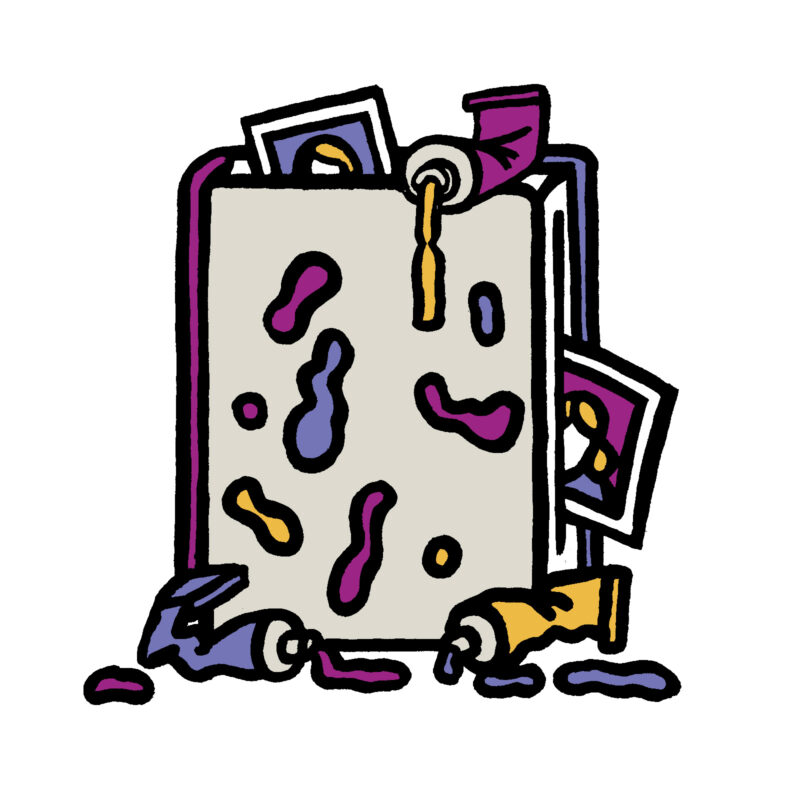When I was a young queer making my way through the early aughts, the anthologies of Mattilda Bernstein Sycamore transformed my life and the lives of those around me. In college we passed around That’s Revolting: Queer Strategies for Resisting Assimilation and Nobody Passes: Rejecting the Rules of Gender and Conformity like dumpstered lumber that scaffolded new ways of imagining our survival in the world—where being queer was necessarily an identity, a politic, and an ideology.
Touching the Art, Sycamore’s sixth book as a solo author, is a memoir/history that unpacks her relationship with her late visual artist grandmother, the abstract artist Gladys Goldstein—although in this case the notion of solo authorship may be a bit of a misnomer. Perhaps inspired by Sycamore’s early work as an anthologist, this book blurs the lines of genre convention and polyvocality by assembling a multivoiced collage of texture, feeling, and evidence. Sycamore works with archival materials, resuscitated and reconstructed memory, and interviews to produce a collection that’s part art history, part art theory, and part memoir, collapsing the spaces between authorship and authority, and between knowledge production and inheritance.
The book opens with a bouquet of chiasmi—a literary figuration where a phrase is written and then repeated in its reverse order to reveal something true buried inside the sentence—offering up aphorisms about the relationship between art, the self, and the world. She writes, “If art is a gap in feeling, it’s also a feeling of the gap.” These reflective gestures, on a sentence level, mirror both the serpentine unfolding of memory that takes place over the course of the book as well as the geometric logic that structures abstract painting.
Often ekphrastic, Sycamore offers multiple entry points into the visual landscape of her grandmother’s work. Sycamore paints with language, using it as device to translate her grandmother’s canvases into multisensory descriptions that branch off into various sites of memory, analysis, and juxtaposed quotations, modeling how inseparable art and life are. “Pathways of mauve, cobalt, aquamarine, gray and red and purple hues. It’s those chains again, this time in paint, connecting me to you.” The book invites the reader to put down the collection and reconsider their relationship to the visual world at large, and to the book they’re holding as an art object.
The spine of Touching the Art is an exploration of the author’s complex and multidimensional relationship with her grandmother. And yet the modular, wide-ranging, and lyric structure, which echoes some of the formal work of Sycamore’s previous book, The Freezer Door, makes an argument that in order to fully touch any experience, it is essential to view it within its wider and more diffuse context. Thus, the book is built from narratives of her life with her grandmother, marginalia from her grandmother’s life and work, the gendered politics of abstract expressionism, familial homophobia, the history of Baltimore, racialized violence and white flight, desire and estrangement. By collaging these various fragments together, Sycamore offers a truer, more dynamic living portrait and makes a claim about queer time and geography that challenges us to push against notions of linearity and inherited borders.
The book’s title, Touching the Art, also resonates on multiple levels. It is both one person’s attempt at getting closer to a person and the art form they worked in, and it is asking us, the reader, to do this as well. It asks us to place our hand and tongue directly on the painting, to know that it becomes ours through this contact, and that both we and the artwork will be changed by our touch.
Publisher: Soft Skull Press Page count: 304 Price: $27.00 Key quote: “Art is always a mystery, even when it’s not a mystery. How it affects us, or fails to. How we fail. How art fails us.” Shelve next to: Sarah Schulman, Hilton Als, Douglas Crimp, David Wojnarowicz Unscientifically calculated reading time: Two packs of cigarettes, one reckless flirtation, and a lovely day at Mountain View Cemetery





